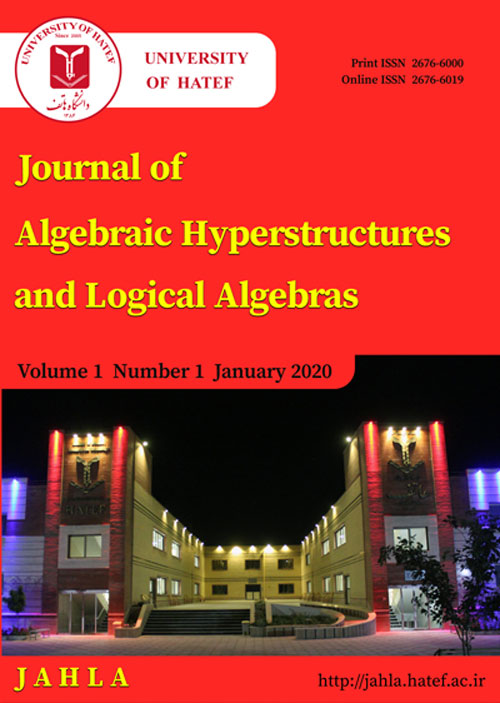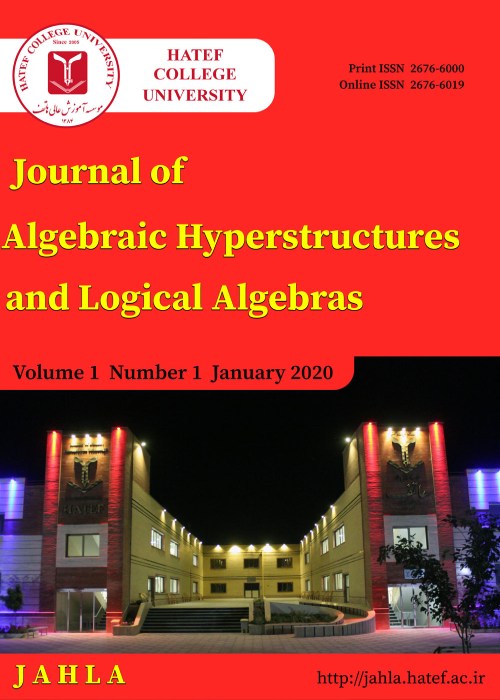فهرست مطالب

Journal of Algebraic Hyperstructures and Logical Algebras
Volume:1 Issue: 1, Winter 2020
- 114 صفحه،
- تاریخ انتشار: 1398/11/29
- تعداد عناوین: 7
-
-
Pages 1-20In the paper, we present EMV-algebras as a common generalization of MV-algebras and generalized Boolean algebras where a top element is not assumed a priori. In addition, we present a non-commutative generalization of EMV-algebras, pseudo MV-algebras and of generalized Boolean algebras. We present main representation results showing a very close connection of pseudo EMValgebra with pseudo MV-algebras, and we give a categorical representation of the category o pseudo EMValgebras without top element. We study also states as analogs of finitely additive states, their topological properties, and we present an integral representation of states by σ-additive probability measures. The paper is a survey over papers [13]{[19].Keywords: MV-algebra, EMV-algebra, pseudo EMV-algebra, maximal, normal ideal, statemorphism
-
Pages 21-36The largest class of hyperstructures is the one which satisfy the weak axioms. These are called Hv-structures introduced in 1990 and they proved to have a lot of applications on several sciences. The main tool in the study of Hv-structures is the ’fundamental structure’ which is based on the ’fundamental relations’. These relations connect the hyperstructures with the corresponding classical structures. One cannot find the fundamental classes in an analytic way since they depend on the results of hyperoperations used. In this paper we focus on the fact that the fundamental classes depend on the results which gives new proofs and a lot of new important, for applications, large classes of hyperstructures.Keywords: Hv-structures, Hv-rings, Hv-fields, h, v-structures, deta-hopes
-
Pages 37-47In this paper, we apply m-polar fuzzy set to hyper BCKalgebra. We introduce the notions of k-polar fuzzy hyper BCK-ideal, k-polar fuzzy weak hyper BCK-ideal, k-polar fuzzy s-weak hyper BCK-ideal, k-polar fuzzy strong hyper BCK-ideal and k-polar fuzzy reflexive hyper BCKideal, and investigate related properties and their relations. We discuss k-polar fuzzy (weak, s-weak, strong, reflexive) hyper BCK-ideal in relation to k-polar level setKeywords: Hyper BCK-algebra, k-polar fuzzy (weak, s-weak, strong, reflexive) hyper BCK-ideal
-
Pages 49-59We use mathematics of uncertainty to analyze the relationship between the sustainable development goals and human trafficking. This comes about naturally due to the use of multiplication in the determination of metrics in scoring categories by the Stakeholder Forum. We develop a method for ranking the members of the Organization for Economic Cooperation and Development in their achievement of the sustainable development goals that are pertinent to trafficking in humans. This method includes linear equations involving ten of the SDGs. SGD 5 (Gender Equality), 8 (Decent Work and Economic Growth), and 16 (Peace, Justice, and Strong Institutions) carry the most weight in determining these rankings. We found that Denmark, Finland, Iceland, and Sweden rank thehighest in achieving the sustainable development goals pertinent to human trafficking. We discuss how our methods can be placed in a setting of fuzzy hyperstructures.Keywords: Sustainable development goals, Human Trafficking, mathematics of uncertainty, Dempster-Shafer theory, Analytical Hierarchy Process
-
Pages 61-77In this paper, by considering the notion of hoop, were introduced by Bosbach in [7, 8] under the name of complementary semigroups, we show that there are relations among hoops and some of other logical algebras such as residuated lattices, MT L-algebras, BL-algebras, MV-algebras, BCK-algebras, equality algebras, EQ-algebras, R0-algebras, Hilbert algebras, Heyting algebras, Hertz algebras, lattice implication algebras and fuzzy implication algebras. The aim of this paper is to find that under what conditions hoops are equivalent to these logical algebras.Keywords: Hoop, residuated lattice, Equality algebra, EQ-algebra, Hilbert algebra
-
Pages 79-93In this paper, first we consider homomorphisms and also strong homomorphisms between hyper residuated lattices, and their properties are presented. Then we use strong homomorphisms to introduce the category of hyper residuated lattices. We show that this category is neither complete but not cocomplete. Moreover, we find some conditions under which the equalizers and pullbacks exist. Finally, we verify subdirectly irreducible hyper residuated lattices and attempt to construct a hyper residuated lattice from a residuated lattice.Keywords: Hyper residuated lattice, category, Terminal, initial
-
Pages 95-105
Commutative neutrosophic quadruple ideals and BCKalgebras are discussed, and related properties are investigated. Conditions for the neutrosophic quadruple BCKalgebra to be commutative are considered. Given subsets A and B of a neutrosophic quadruple BCK-algebra, conditions for the set NQ (A; B) to be a commutative ideal of a neutrosophic quadruple BCK-algebra are provided.
Keywords: BCK-algebra, ideal, neutrosophic quadruple ideal, commutative neutrosophic quadruple BCK-algebra


